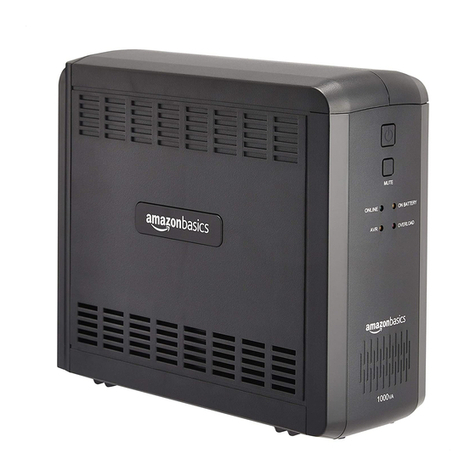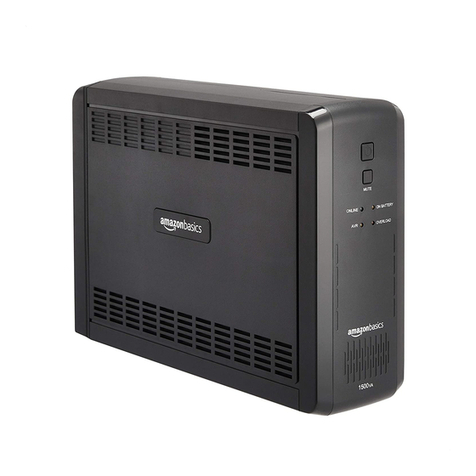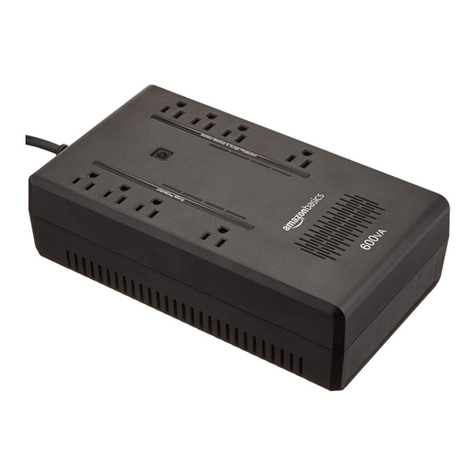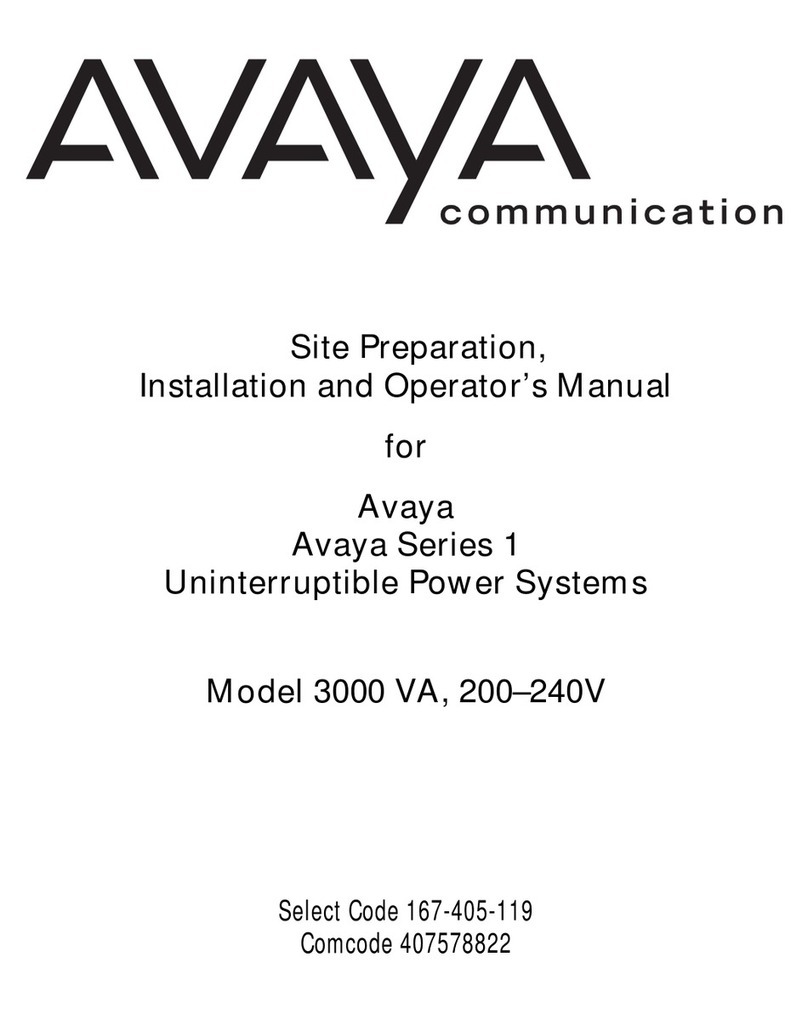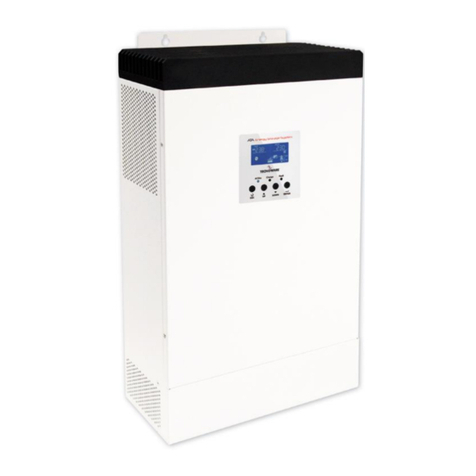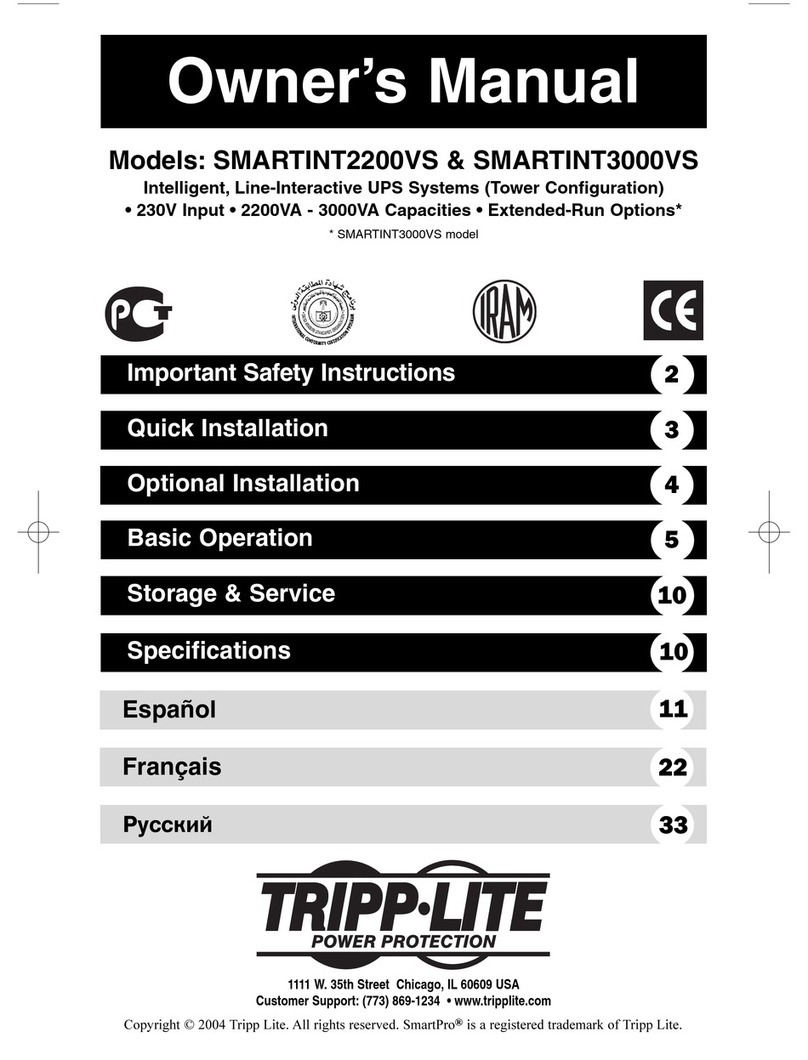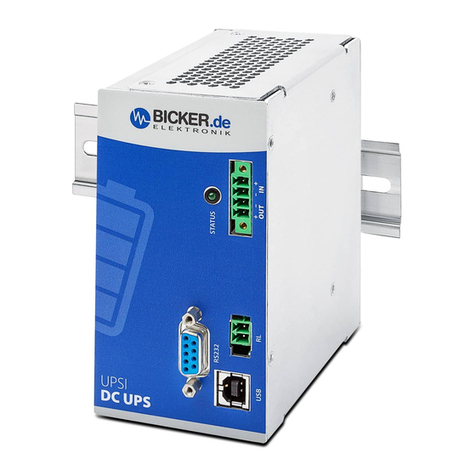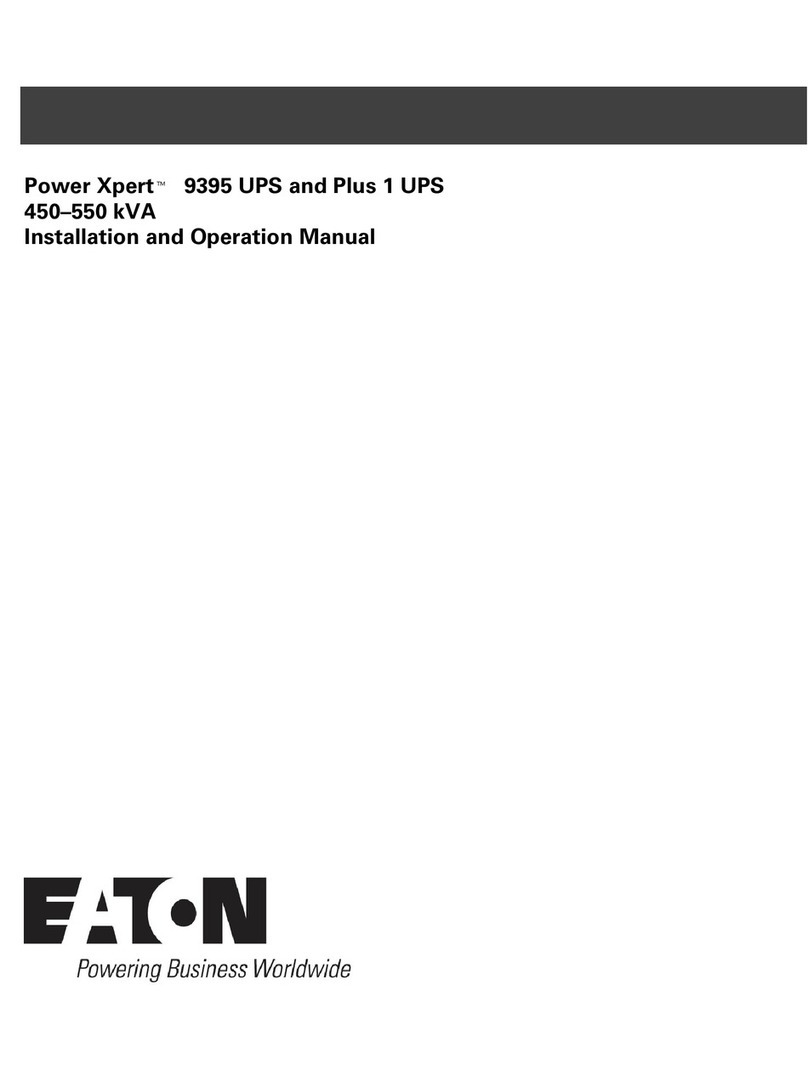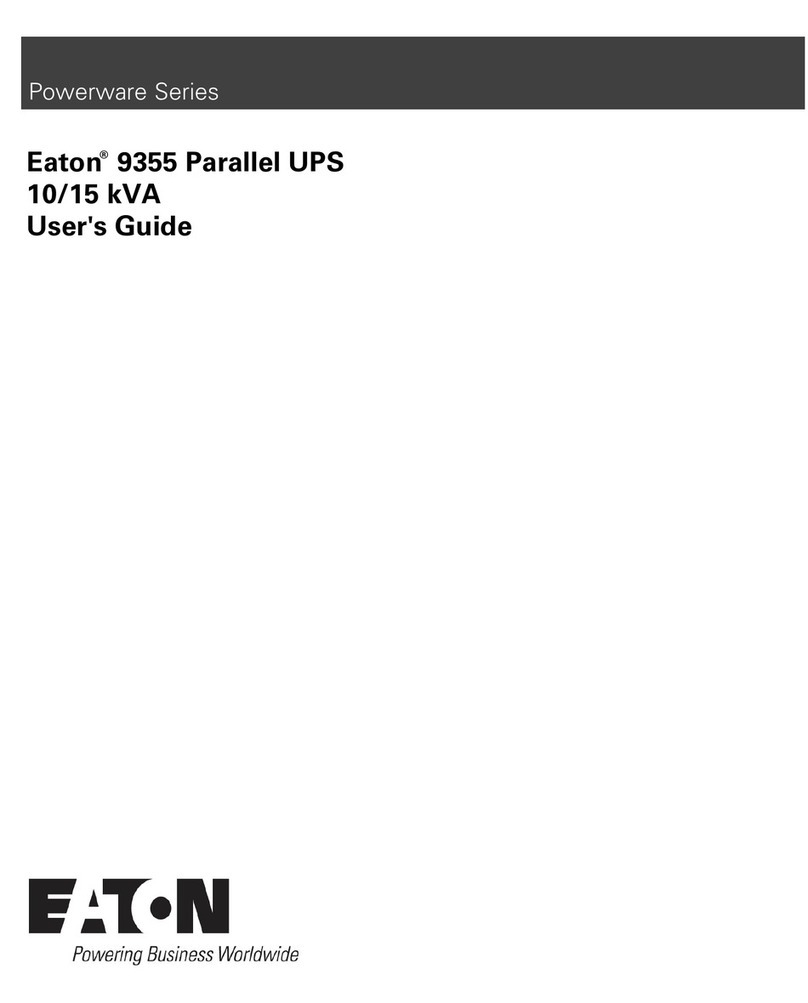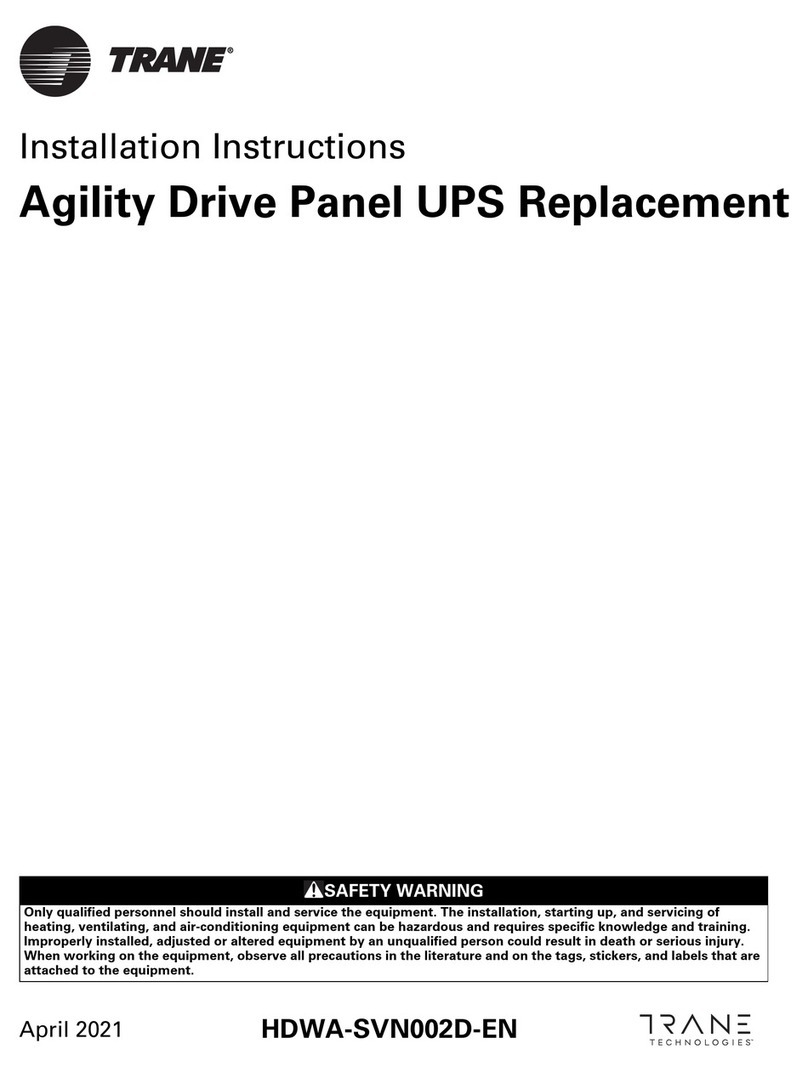AmazonBasics B073Q48Z95 User manual

B073Q48Z95
Standby UPS 400VA 255W, 6 Outlets
UPS De Respaldo 400VA, 255 W, 6 Tomas
Alimentation Sans Interruption (ASI) 400 VA 255 W,
6Prises
400VA
K01-1198005-02

English ..................................... 3
Español.................................. 11
Français ................................. 19

3
Welcome Guide •English
Standby UPS 400VA 255W, 6 Outlets
Contents:
Before getting started, ensure the package contains the following components:
Description
400VA
Battery Backup & Surge Protection
Surge Protection Circuit Breaker
Push to Reset

4
Basic Operation
1. Battery and Surge Protected Outlets
The unit has three battery and surge protected outlets to ensure temporary uninterrupted
operation of your equipment during a power failure. (Do not plug a laser printer, paper
shredder, copier, space heater, vacuum, sump pump or other large electrical device into
the “Battery and Surge Protected Outlets.” The power demands of these devices will
overload and possibly damage the unit.).
2. Full-Time Surge Protection Outlets
The unit has three surge suppression outlets to provide surge and line noise protection.
3. Power Switch
To turn the UPS on, press the power button for approximately 2 seconds - you will hear a
constant tone (1 second) - and release after a short beep.
To turn the UPS off, press the power button for approximately 2 seconds - you will hear a
constant tone (1 second) - and release after two short beeps.
Quickly press the POWER button twice can turn off or turn on the audible Alarm. The default
setting is for the Alarm On.
To turn the alarm off, press the power button twice. You will hear two short beeps when the
alarm is turned off.
To turn the alarm back on, press the power button twice. You will hear a short beep when the
alarm is turned on.
*When the alarm is turned off, no audible notification when the UPS reaches a (low)
battery state.
4. Power On Indicator (green)
This LED is illuminated when the utility power is normal and the UPS outlets are providing
power, free of surges and spikes. When In the event of a complete power loss, severe
brownout, or over-voltage, the UPS will turn to battery mode and the LED will flash.
Please refer to the following “Definitions for Illumination LED Indicators” for more information.
5. Circuit Breaker
Located on the side of the UPS, the circuit breaker serves to provide overload and fault
protection.
6. Outlets Designed for AC Adapters
The UPS unit has two widely-spaced outlets, so AC power adapters can be plugged into the
UPS without overlapping or blocking adjacent outlets.

5
Important Safety Warnings
(SAVE THESE INSTRUCTIONS)
• This manual contains important instructions that should be followed during installation and
maintenance of the UPS and batteries.
• CAUTION! To prevent the risk of fire or electric shock, install in a temperature and humidity
controlled indoor area free of conductive contaminants. (Please see specifications for
acceptable temperature and humidity range).
• CAUTION! To reduce the risk of electric shock, do not remove the cover. There are no user
serviceable parts inside.
• CAUTION! Hazardous live parts inside can be energized by the battery even when the AC input
power is disconnected.
• CAUTION! The UPS must be connected to an AC power outlet with fuse or circuit breaker
protection. Do not plug into an outlet that is not grounded. If you need to de-energize this
equipment, turn off and unplug the unit.
• CAUTION! To avoid electrical shock, turn off the unit and unplug it from the AC power source
before servicing the battery or equivalent.
• CAUTION! Not for use in a computer room as defined in the Standard for the Protection of
Electronic Computer/Data Processing Equipment, ANSI/NFPA 75.
• CAUTION! To reduce the risk of fire, connect only to a circuit provided with 20 amperes
maximum branch circuit over current protection in accordance with the National Electric Code,
ANSI/NFPA 70.
• CAUTION! Risk of explosion if battery is replaced by an incorrect type. Batteries shall be
installed by service personnel, and the replacement of batteries with a suitable recommended
type. Dispose of used batteries according to the instructions.
• CAUTION! Do not dispose of batteries in a fire. The batteries may explode.
• CAUTION! Do not open or mutilate batteries. Released electrolyte is harmful to the skin and
eyes. It may be toxic.
• DO NOT USE FOR MEDICAL OR LIFE SUPPORT EQUIPMENT! AmazonBasics does not
sell products for life support or medical applications. Do not use in any circumstance that would
affect operation and safety of life support equipment, any medical applications or patient care.
• DO NOT USE WITH OR NEAR AQUARIUMS! To reduce the risk of fire or electric shock, do
not use with or near an aquarium. Condensation from the aquarium can cause the unit to short
out.
• DO NOT USE THE UPS ON ANY TRANSPORTATION! To reduce the risk of fire or electric
shock, do not use the unit on any transportation such as airplanes or ships. The effect of shock
or vibration caused during transit and the damp environment can cause the unit to short out.
• WARNING! This product contains chemicals known to State of California to cause cancer and
birth defects or other reproductive harm.

6
Installing Your UPS System
Unpacking
Inspect the UPS upon receipt. The box should contain the following:
(a) UPS unit (b) User’s manual
How To Determine The Power Requirements Of Your Equipment
1. Ensure that the equipment plugged into the UPS does not exceed the UPS unit’s rated capacity
(400 VA/255 W). If the rated capacities of the unit are exceeded, an overload condition may
occur and cause the UPS unit to shut down or the circuit breaker to trip.
2. There are many factors that can affect the amount of power that your computer system will
require. For optimal system performance, keep the load below 80% of the unit’s rated capacity.
Hardware Installation Guide
1. Your new UPS may be used immediately upon receipt. However, after receiving a new UPS,
to ensure the battery’s maximum charge capacity, it is recommended that you charge the
battery for at least 8 hours. Your UPS is equipped with an auto-charge feature. When the UPS
is plugged into an AC outlet, the battery will automatically charge whenever the UPS is turned
on or turned off.
2. With the UPS unit turned off and unplugged, connect your equipment requiring battery backup
into the battery power supplied outlets. Plug the other peripheral equipment (printer, scanner,
speakers) into the full-time surge protection outlets. Do not plug a laser printer, paper
shredder, copier, space heater, vacuum, sump pump or other large electrical device into
the “Battery and Surge Protected Outlets”. The power demands of these devices will
overload and possibly damage the unit.
3. Plug the UPS into a 2 pole, 3 wire grounded receptacle (wall
outlet). Make sure the wall branch outlet is protected by a fuse or
circuit breaker and does not service equipment with large electrical
demands (e.g. air conditioner, refrigerator, copier, etc…). The
warranty prohibits the use of extension cords, outlet strips, and surge
strips in conjunction with the UPS.
4. Press the power switch to turn the unit on. The Power On indicator will illuminate green and the
unit will “beep” twice.

7
5. If an overload is detected, an audible alarm will be sounded and the unit will emit long beep.
To correct this, turn the UPS off and unplug at least one piece of equipment from the battery
power supplied outlets. Make sure the circuit breaker is depressed and then turn the UPS on.
6. To maintain optimal battery charge, leave the UPS plugged into an AC outlet at all times.
7. To store the UPS for an extended period, cover it and store with the battery fully charged. While
in storage, recharge the battery every three months to ensure battery life.
8. For pluggable equipment, the socket-outlet shall be installed
near the equipment and shall be easily accessible.
9. Do not lie or mount the UPS down on its side to ensure the
battery life.
Denitions For Illuminated LED Indicators
Power ON Alarm
CONDITION
On Off Normal
Flash when
Beeps
Beeps twice every
30 seconds
Utility Failure - Battery Mode
The UPS is providing power to battery and surge
protected outlets from its battery.
Flash when
Beeps
Rapid Beeping
every
1/2 second
Utility Failure - Low Battery
The UPS is providing battery power. Rapid beeping
indicates the unit will run out of power shortly.
On Constant tone
Overload -Occurs when connected equipment
exceeds the listed capacity of the UPS. Turn the UPS
off, unplug at least one piece of equipment from battery
outlets, reset the circuit breaker and turn the unit on.
Off Constant tone Charge Fault - In line mode, the battery charging
voltage is too high or too low.
Off Constant tone Utility Failure - The frequency is beyond 47-63 Hz. The
UPS will not turn on in line mode.
400VA

8
Technical Specications
Model Standby UPS 400VA 255W, 6 Outlets
Capacity 400 VA / 255 W
Brownout Transfer 96 VAC typical
Over-Voltage Transfer 140 VAC typical
Nominal Input Voltage 120 VAC
On-Battery Output Voltage 120 VAC ± 8 %
On-Battery Output Frequency 50/60 Hz ± 1 %
Transfer Time 8 ms Typical
Max. Load for UPS Outlets
(3 Outlets) 400 VA / 255 W
Max. Load for Full-Time Surge
Protection outlets (6 Outlets) 10 Amps
On-Battery Output Wave Form Simulated Sine Wave
Operating Temperature + 32 °F to 104 °F / 0 °C to 40 °C
Operating Relative Humidity 0 to 95 % non-condensing
Size (L x W x H) 7.2 x 4.3 x 3.2 in. (184 x 110 x 82 mm)
Net Weight 3.59 lbs (1.63 kg)
Typical Battery Recharge Time 8 hours typical from total discharge
Typical Battery Life 3 to 6 years, depending on number of discharge/
recharge cycles
Recommended Battery Sealed Maintenance Free Lead Acid Battery
Safety Approvals UL, cUL, FCC Class B, ICES-003: Class B, CEC
System Function Block Diagram
Input
Output
EMI Filter
Battery Inverter
Surge
Suppressor
Charger
AC / DC
Normal Mode
Battery Mode

9
Troubleshooting
Problem Possible Cause Solution
Full-time surge protection
outlets stop providing power
to equipment. Circuit breaker
button is projecting from the
side of the unit.
Circuit breaker has
tripped due to an
overload.
Turn the UPS off and unplug at least one
piece of equipment. Wait 10 seconds,
reset the circuit breaker by pressing the
button, and then turn the UPS on.
The UPS does not perform
expected runtime.
Battery not fully
charged.
Recharge the battery by leaving the UPS
plugged in.
Battery is worn
out.
Please contact Amazon about
replacement batteries.
The UPS will not turn on.
The on/off switch
is designed to
prevent damage
from rapidly turning
it off and on.
Turn the UPS off. Wait 10 seconds and
then turn the UPS on.
The unit is not
connected to an
AC outlet.
The unit must be connected to a
110/120 V 50/60 Hz outlet.
The battery is worn
out.
Please contact Amazon about
replacement batteries.
Mechanical
problem. Please contact Amazon.
The frequency
is outside of the
operating range of
47-63 Hz.
Turn the UPS off. Make sure the
frequency range is within 47-63 Hz. Or
you can turn on with battery mode.

10
FCC Information
This equipment has been tested and found to comply with the limits for a Class B digital device,
pursuant to Part 15 of the FCC Rules. These limits are designed to provide reasonable protection
against harmful interference in a residential installation. This equipment generates, uses and can
radiate radio frequency energy and, if not installed and used in accordance with the instructions,
may cause harmful interference to radio communications. However, there is no guarantee that
interference will not occur in a particular installation.
If this equipment does cause harmful interference to radio or television reception, which can be
determined by turning the equipment off and on, the user is encouraged to try to correct the
interference by one or more of the following measures:
• Reorient or relocate the receiving antenna.
• Increase the separation between the equipment and receiver.
• Connect the equipment into an outlet on a circuit different from that to which the receiver is
connected.
• Consult the dealer or an experienced radio/TV technician for help.
Changes or modifications not expressly approved by the party responsible for compliance may
cause interference and void the user’s authority to operate the equipment. This device complies
with Part 15 of the FCC Rules. Operation is subject to the following two conditions: (1) This device
may not cause harmful interference, and (2) this device must accept any interference received,
including interference that may cause undesired operation.
IC Regulatory Statement
This device complies with Industry Canada licence-exempt RSS standard(s). Operation is subject
to the following two conditions: (1) this device may not cause interference, and (2) this device must
accept any interference, including interference that may cause undesired operation of the device.
Feedback and Help
Love it? Hate it? Let us know with a customer review.
AmazonBasics is committed to delivering customer-driven products that live up to your high
standards. We encourage you to write a review sharing your experiences with the product.
amazon.com/review/review‑your‑purchases#
amazon.com/gp/help/customer/contact‑us

11
Guía De Bienvenida • Español
UPS De Respaldo 400VA, 255 W,
6 Tomas
Contenido:
Antes de comenzar, asegúrese de que la caja contenga los siguientes componentes:
Descripción
400VA
Batería de respaldo y protección contra sobrecargas
Protección contra sobrecargas
Disyuntor
Presione para restablecer

12
Funcionamiento Básico
1. Batería Y Tomas Con Protección Ante Sobrecargas
La unidad posee tres tomas con protección ante sobrecargas para garantizar un
funcionamiento temporal sin interrupciones de sus equipos durante un corte de energía.
(No enchufe una impresora láser, trituradora de papel, fotocopiadora, calefactores,
aspiradoras, bombas de sumidero u otros dispositivos eléctricos grandes en la “Batería
y tomas con protección ante sobrecargas”. La energía que requieren estos dispositivos
sobrecargará y, posiblemente, dañará la unidad).
2. Tomas Con Protección Constante Ante Sobrecargas
La unidad posee tres tomas de supresión de sobrecargas para proteger ante ruido en la línea
y sobrecargas.
3. Interruptor De Encendido
Para encender la unidad UPS, presione el botón de encendido durante aproximadamente
2 segundos (escuchará un tono constante durante 1 segundo) y luego suéltelo tras escuchar
un breve bip.
Para apagar la unidad UPS, presione el botón de encendido durante aproximadamente
2 segundos (escuchará un tono constante durante 1 segundo) y luego suéltelo tras escuchar
dos breves bip.
Presione rápidamente el botón POWER dos veces para activar o desactivar la alarma sonora.
El ajuste predeterminado de la alarma es que esté activada.
Para desactivar la alarma, presione el botón de encendido dos veces. Escuchará dos bip
breves cuando la alarma se desactive.
Para volver a encender la alarma, presione el botón de encendido dos veces. Escuchará un bip
breve cuando la alarma se active.
*Cuando la alarma esté apagada, no se producirán alarmas sonoras cuando la unidad
UPS llegue a un nivel de batería baja.
4. Indicador De Encendido (verde)
Este LED se enciende cuando la energía está en estado normal y las tomas de la unidad UPS
están suministrando energía, libre de sobrecargas y variaciones de corriente. En caso de un
corte total de energía, baja de tensión severa o sobrevoltaje, la unidad UPS cambiará a modo
batería y el LED parpadeará.
Consulte “Definiciones de la iluminación de los indicadores LED” para obtener más información.
5. Disyuntor
Se encuentra en el costado de la unidad UPS y sirve como protección ante sobrecarga y fallas.
6. Tomas Diseñadas Para Adaptadores De CA
La unidad UPS posee dos tomas separadas por un espacio considerable, para poder conectar
adaptadores de energía de CA en la unidad sin que se superpongan ni bloqueen las tomas
adyacentes.

13
Instrucciones De Seguridad Importantes
(GUARDE ESTAS INSTRUCCIONES)
• Este manual del usuario contiene instrucciones importantes que se deben seguir durante la
instalación y mantenimiento del SAI y las baterías.
• ¡PRECAUCIÓN! Para evitar riesgos de incendio o descarga eléctrica, instale en un área interior
con temperatura y humedad controladas, libre de contaminantes conductores. (Consulte las
especificaciones para conocer el rango de temperatura y humedad aceptable).
• ¡PRECAUCIÓN! Para reducir el riesgo de descarga eléctrica, no quite la tapa. En su interior, no
hay piezas que usted pueda reparar.
• ¡PRECAUCIÓN! Las piezas internas pueden estar energizadas por la batería incluso cuando la
alimentación de entrada de CA está desconectada.
• ¡PRECAUCIÓN! La unidad UPS debe conectarse a una toma de corriente CA protegida
por fusibles o disyuntor. No conecte a una toma que no tenga conexión a tierra. Si necesita
desenergizar este equipo, apague y desconecte la unidad.
• ¡PRECAUCIÓN! Para evitar descargas eléctricas, apague la unidad y desconéctela de la fuente
de alimentación de CA antes de realizar tareas de mantenimiento de baterías o equivalentes.
• ¡PRECAUCIÓN! No usar en una sala computacional según lo indica el Estándar de Protección
de Computadoras Electrónicas/Equipos de Procesamiento de Datos, ANSI/NFPA 75.
• ¡PRECAUCIÓN! Para reducir el riesgo de incendios, conecte solo a un circuito que posea
un corte de corriente de protección máximo de 20 amperes, en cumplimiento con el Código
Eléctrico Nacional, ANSI/NFPA 70.
• ¡PRECAUCIÓN! Riesgo de explosión si la batería se reemplaza por una del tipo incorrecto.
Las baterías deben ser instalada por personal de servicio, y las de repuesto deben ser del tipo
recomendado. Deseche las baterías usadas siguiendo las instrucciones.
• ¡PRECAUCIÓN! No deseche las baterías quemándolas. Las baterías pueden explotar.
• ¡PRECAUCIÓN! No abra ni mutile las baterías. El electrolito que se libera es dañino para la piel
y los ojos. Podría ser tóxico.
• ¡NO USAR PARA EQUIPO MÉDICO O DE SOPORTE VITAL! AmazonBasics no vende
productos de soporte vital ni dispositivos médicos. No usar bajo ninguna circunstancia que
pueda afectar la operación y seguridad del equipo de soporte vital, de alguna aplicación
médica o del cuidado de un paciente.
• ¡NO USAR CON, NI CERCA DE, ACUARIOS! Para reducir el riesgo de descarga eléctrica,
no use con, ni cerca de, acuarios. La condensación del acuario puede provocar que la unidad
haga cortocircuito.
• ¡NO UTILICE LA UNIDAD UPS EN MEDIOS DE TRANSPORTE! Para reducir el riesgo de
descarga eléctrica, no use la unidad en medios de transporte, como aviones o barcos. El
efecto de golpe o vibración provocado durante el transporte y el entorno húmedo pueden
provocar un cortocircuito de la unidad.
• ¡ADVERTENCIA! Este producto contiene químicos que, según la información que posee el
Estado de California, provoca cáncer y defectos congénitos u otro daño reproductivo.
•

14
Instalación De Su Sistema UPS
Desembalaje
Inspeccione la unidad UPS al recibirla. La caja debe incluir lo siguiente:
(a) Unidad UPS (b) Manual del usuario
Cómo Determinar Los Requisitos De Alimentación De Su
Equipo
1. Asegúrese de que el equipo conectado a la unidad UPS no sobrepase su capacidad nominal
(400 VA/255 W). Si se sobrepasa la capacidad nominal de la unidad, podría ocurrir una
condición de sobrecarga y provocar que la unidad UPS se apague o que el disyuntor se active.
2. Hay muchos factores que pueden afectar la cantidad de potencia que su computadora pueda
necesitar. Para lograr un óptimo desempeño del sistema, mantenga la carga bajo el 80 % de la
capacidad nominal de la unidad.
Guía De Instalación
1. Su nueva unidad UPS puede usarse inmediatamente al recibirla. Sin embargo, tras recibir
una nueva unidad UPS, para lograr máxima capacidad de carga de la batería, se recomienda
cargarla durante, al menos, 8 horas. Su unidad UPS posee una característica de carga
automática. Cuando la unidad UPS está conectada a una toma de CA, la batería se carga
automáticamente cuando la unidad UPS se enciende o apaga.
2. Con la unidad UPS apagada y desenchufada, conecte su equipo que requiera una batería
de respaldo a las tomas de la unidad UPS. Enchufe el resto del equipo periférico (impresora,
escáner, altavoces) a tomas con protección constante ante sobrecargas. No enchufe
una impresora láser, trituradora de papel, fotocopiadora, calefactores, aspiradoras,
bombas de sumidero u otros dispositivos eléctricos grandes en la “Batería y tomas con
protección ante sobrecargas”. La energía que requieren estos dispositivos sobrecargará
y, posiblemente, dañará la unidad.
3. Conecte la unidad UPS a un receptáculo (toma de pared) de 2 polos
y cableado a tierra de 3 cables. Asegúrese de que la toma de pared
esté protegida por un fusible o disyuntor y que no energice equipos
con una demanda energética demasiado grande (sistemas de aire
acondicionado, refrigeradores, fotocopiadoras, etc.). La garantía
prohíbe el uso de cables de extensión, cables de extensión con
múltiples tomas y tomas de sobrecarga junto con la unidad UPS.
4. Presione el interruptor de encendido para encender la unidad. El indicador de encendido se
volverá de color verde y la unidad hará “bip” dos veces.

15
5. Si se detecta una sobrecarga, sonará una alarma y la unidad emitirá un sonido bip largo.
Para corregir esto, apague la unidad UPS y desenchufe al menos un equipo de las tomas de
alimentación de la batería. Asegúrese de que el disyuntor del circuito esté activado y encienda
la unidad UPS.
6. Para mantener una carga óptima de la batería, deje la unidad UPS conectada a una toma de
CA en todo momento.
7. Para almacenar la unidad UPS durante un periodo de tiempo extenso, cúbrala y almacénela
con la batería completamente cargada. Mientras esté almacenada, recargue la batería cada
tres meses para garantizar su correcto funcionamiento.
8. Para equipos conectables, la toma se debe instalar cerca del equipo y
debe ser fácil acceder a ella.
9. Para proteger la vida útil de la batería, no deje ni monte la unidad
UPS sobre uno de sus costados.
Deniciones De La Iluminación De Los
Indicadores LED
Encendido Alarma
CONDICIÓN
Encendido Apagado Normal
Parpadea al
hacer bip
Parpadea dos veces
cada 30 segundos
Modo batería a prueba de fallas
La unidad UPS proporciona energía a las tomas con
protección ante sobrecargas desde su batería.
Parpadea al
hacer bip
Bip rápido cada
1/2 segundo
Falla de la unidad - Batería baja
La unidad UPS está proporcionando energía con la
batería. Un sonido bip rápido indica que la unidad se
quedará sin energía en breve.
Encendido Tono constante
Sobrecarga: ocurre cuando el equipo conectado
sobrepasa la capacidad de la unidad UPS. Apague
la unidad UPS, desenchufe al menos un equipo
de las tomas de batería, restablezca el disyuntor y
encienda la unidad.
Apagado Tono constante Error de carga: en modo línea, el voltaje de carga de
la batería es demasiado alto o bajo.
Apagado Tono constante Falla utilitaria: la frecuencia supera los 47-63 Hz.
La unidad UPS no encenderá en modo línea.
400VA

16
Especicaciones Técnicas
Modelo UPS De Respaldo 400 VA, 255 W, 6 Tomas
Capacidad 400 VA / 255 W
Transferencia de Baja de Tensión 96 VAC típica
Transferencia de Sobretensión 140 VAC típica
Voltaje de Entrada Nominal 120 VAC
Voltaje de salida con batería 120 VAC ± 8 %
Frecuencia de salida con batería 50/60 Hz ± 1 %
Tiempo de transferencia 8 ms Típico
Carga máxima de las tomas UPS (3 tomas) 400 VA / 255 W
Carga máxima para las tomas de protección
constante contra sobrecargas (6 tomas) 10 Amps
Forma de la onda de salida con batería Onda senoidal simulada
Temperatura operativa + 32 °F a 104 °F / 0 °C a 40 °C
Humedad relativa operativa 0 a 95 % sin condensación
Dimensiones (Largo x Ancho x Alto) 7.2 x 4.3 x 3.2 pulgadas (184 x 110 x 82 mm)
Peso neto 3.59 lbs (1.63 kg)
Tiempo de recarga típico de la batería Normalmente 8 horas desde una descarga total
Vida útil típica de la batería 3 a 6 años, dependiendo de la cantidad de
ciclos de descarga/recarga
Batería recomendada Batería de ácido con plomo sellada y sin
necesidad de mantenimiento
Aprobaciones de seguridad UL, cUL, FCC Clase B, ICES-003: Clase B, CEC
Diagrama De Bloque De Funcionamiento Del Sistema
Entrada Salida
Filtro EMI
Batería Inversor
Supresor
de cargas
Cargador
CA / CC
Modo normal
Modo batería

17
Resolución De Problemas
Problema Causa probable Solución
Las tomas de protección
constante ante sobrecargas
dejaron de alimentar el
equipo. El botón del disyuntor
está asomado desde el
costado de la unidad.
El disyuntor se
activó debido a una
sobrecarga.
Apague la unidad UPS y desconecte
al menos un equipo. Espere
10 segundos, reinicie el disyuntor
presionando el botón y luego
encienda la unidad UPS.
La unidad UPS no funciona
durante el tiempo esperado.
La batería no está
completamente
cargada.
Recargue la batería dejando la
unidad UPS conectada.
La batería está
agotada.
Contacte a Amazon para saber más
sobre las baterías de reemplazo.
La unidad UPS no se
enciende.
El interruptor de
encendido/apagado
está diseñado
para evitar daños
provocados por un
apagado y encendido
rápidos.
Apague la unidad UPS. Espere
10 segundos y encienda la unidad
UPS.
La unidad no está
conectada a una toma
de CA.
La unidad debe conectarse a una
toma de 110/120 V 50/60 Hz.
La batería está
agotada.
Contacte a Amazon para saber más
sobre las baterías de reemplazo.
Problema mecánico. Contacte a Amazon.
La frecuencia está
fuera del rango
operativo de
47-63 Hz.
Apague la unidad UPS. Asegúrese
de que el rango operativo esté entre
47-63 Hz. O bien puede encender la
unidad en modo batería.

18
Comentarios y Ayuda
¿Le encanta? ¿No le gusta nada? Escriba una opinión como cliente.
En AmazonBasics nos comprometemos a proveer productos pensados para satisfacer a nuestros
clientes y que estén a la altura de sus elevados estándares de calidad. Le animamos a que escriba
una opinión sobre su experiencia con el producto.
amazon.com.mx/review/review‑your‑purchases#
amazon.com.mx/gp/help/customer/contact‑us

19
Guide De Bienvenue • Français
Alimentation Sans Interruption (ASI)
400 VA 255 W, 6Prises
Contenu:
Avant de commencer, assurez-vous que l’emballage comporte les composants suivants:
Description
400VA
Pile de secours et protection contre la surtension
Protection contre
la surtension
Disjoncteur/Réenclenchement
par bouton-poussoir

20
Fonctionnement De Base
1. Prises De La Pile Et Protégées Contre La Surtension
L’appareil est équipé de trois prises de pile et protégées contre la surtension afin de garantir
un fonctionnement temporaire sans interruption de vos équipements en cas de panne
d’électricité. (Ne pas brancher une imprimante laser, une déchiqueteuse de papier, une
photocopieuse, un radiateur, un aspirateur, une pompe de puisard ou tout autre gros
appareil électrique sur les « prises de pile et protégées contre la surtension. » Les
besoins en énergie de ces appareils sont susceptibles de surcharger et d’endommager
éventuellement l’appareil.)
2. Prises De Protection Contre La Surtension En Tout Temps
L’appareil est équipé de trois prises de protection contre la surtension afin d’offrir de une
protection contre la surtension et les bruits de circuits.
3. Commutateur D’alimentation
Pour mettre l’onduleur sous tension, appuyez sur le commutateur d’alimentation pendant
environ 2 secondes - vous entendrez un signal à tonalité constante (1 seconde) - puis relâchez
le commutateur après un signal sonore bref.
Pour mettre l’onduleur hors tension, appuyez sur le bouton d’alimentation pendant environ
2 secondes - vous entendrez un signal à tonalité constante (1 seconde) - puis relâchez le
commutateur après deux signaux sonores brefs.
Appuyez rapidement à deux reprises sur le bouton POWER pour activer ou désactiver l’alarme
sonore. Le réglage par défaut est pour l’alarme activée.
Pour désactiver l’alarme, appuyez à deux reprises sur le bouton d’alimentation. Vous entendrez
deux signaux sonores brefs lorsque l’alarme est désactivée.
Pour réactiver l’alarme, appuyez à deux reprises sur le bouton d’alimentation. Vous entendrez
un signal sonore bref lorsque l’alarme est activée.
*Lorsque l’alarme est désactivée, absence de notification sonore lorsque l’onduleur
atteint un (faible) niveau de charge de la pile.
4. Voyant De Mise Sous Tension (vert)
Ce voyant LED s’allume lorsque l’électricité du service public est normale et que les prises de
l’onduleur fournissent du courant, sans surtension ou pointes de tension. En cas de coupure
de courant complète, de baisses de tension importantes ou de surtension, l’onduleur passe en
mode Pile et le voyant LED clignote. Veuillez vous référer à la section suivante « Définitions des
voyants LED lumineux » pour plus d’informations.
5. Disjoncteur
Situé sur le côté de l’onduleur, le disjoncteur sert à assurer la protection contre la surcharge et
les pannes.
6. Prises Conçues Pour Adaptateurs Secteur
L’onduleur est équipé de deux prises largement espacées entre elles, afin que des adaptateurs
secteur puissent être branchés sur l’onduleur sans chevauchement ou obstruction entre prises
adjacentes.
Table of contents
Languages:
Other AmazonBasics UPS manuals
Popular UPS manuals by other brands
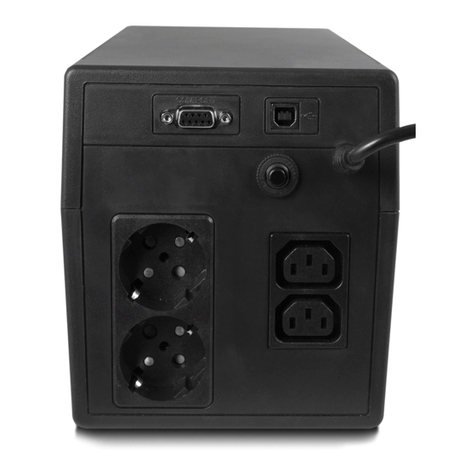
Eminent
Eminent EM394 Series manual
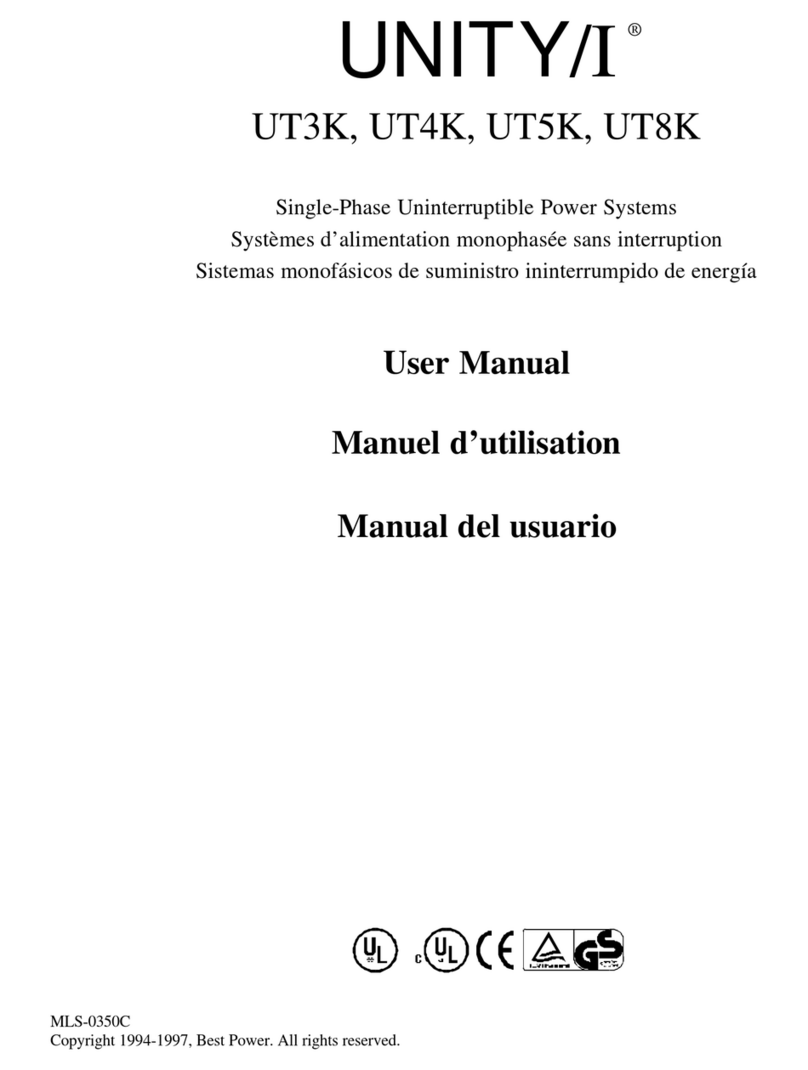
Best Power
Best Power Unity/I UT3K user manual
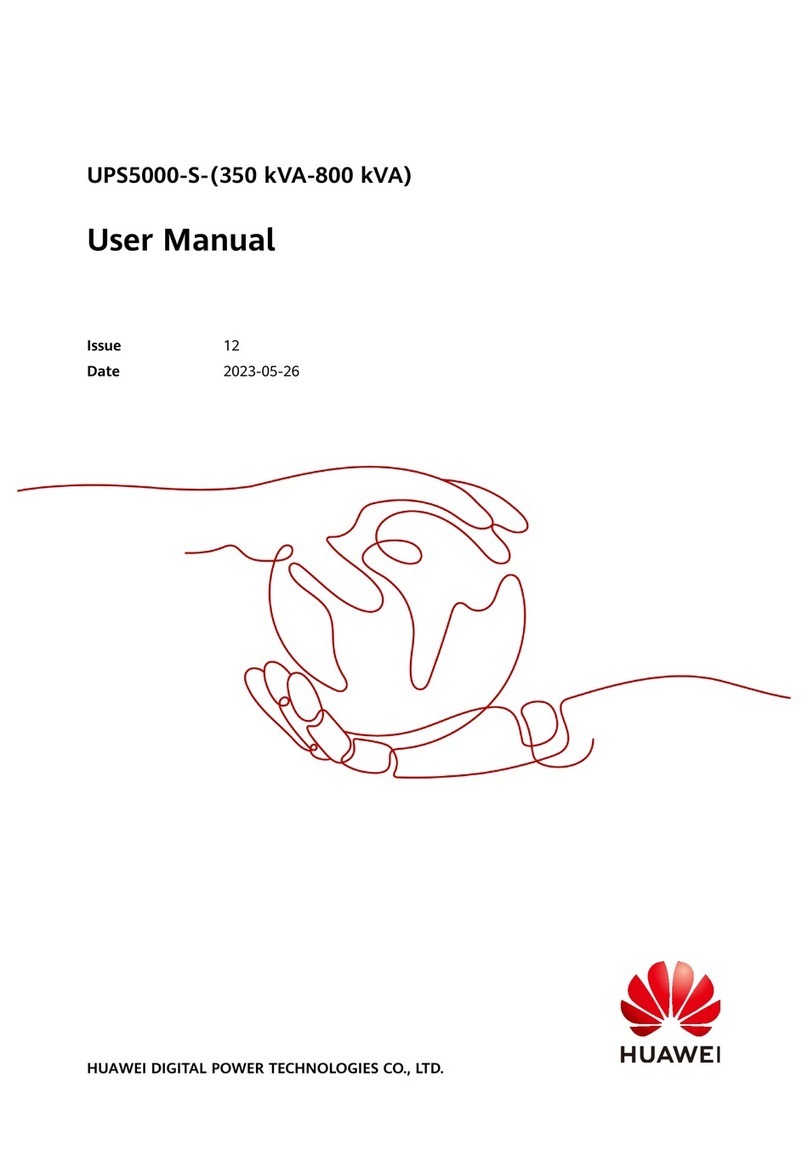
Huawei
Huawei UPS5000-S-400K-SM user manual
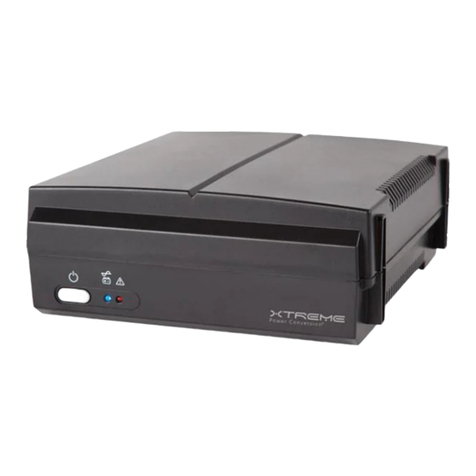
Xtreme Power Conversion
Xtreme Power Conversion XST?400 user manual

CyberPower
CyberPower CPS1000AVR user guide

Eaton
Eaton Power Xpert 9395P-900 Series Installation and operation manual
